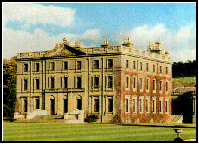The Lawns of Curraghmore
Oh, Granny, hereís a present and it comes a distance too,
All the way from Ireland and it says this to you
Itís a spray of shamrock, the note will tell you more
That it grew in your native birthplace
On the lawns of Curraghmore.
A cushla, let me feel them, little darling is it true?
A cushla, let me feel them, if you say twas there they grew.
It brings me back sweet memories of my childhood days once more
Of the times that we played and rambled
On the lawns of Curraghmore.
I see as once I saw them when a little girl I stood.
The Tower all clad with ivy Ė the Capital Hill and wood
The cotton mills at Mayfield and the road thatís winding o'er.
And the boys and the girls all courting
On the lawns of Curraghmore.
I see as once I saw them when a little girl I stood.
The Tower all clad with ivy Ė the Chapel Hill and wood
The cotton mills at Mayfield and the road thatís winding o'er
On the lawns of Curraghmore.
I have travelled since my childhood, I have travelled near and far,
And of all the scenes Iíve seen, sure theyíre the best by far.
But now that I am blind dear, I know Iíll see no more
The winding River Clodagh
As it flows through Curraghmore.

Curraghmore House. Home
of Lord Waterfor
The village of Portlaw is bounded by Lord Waterford's demense
of Curraghmore, and brings lots of visitors to the area.
The Le Poers or Powers have been settled in East Waterford since Robert Le
Poer came over to Ireland in 1176. Modernisation of their feudal stronghold at
Curraghmore began in the 18th century, and this article illustrates
the rococo plasterwork in the old tower and the charming shell-house in the
garden.
"The Irish," wrote the Elizabethan antiquary Camden some what acidly in his Britannia, "are so wedded to their own customs, that they not only retain themselves, but corrupt the English that come among them." It was certainly curious how soon the Anglo-Normans Who conquered most of Ireland in the 12th century was obsorbed by the people they had overrun. The same process can be watched to a greater or less degree, in a multitude of families-in the Fitzgeralds, Fitzmaurices, Butlers, Burkes, Nugents and Barryís, among others Ėbut nowhere more completely than in the Powers or Le Poers of Curraghmore and the country-side around.
Curraghmore is very much a little world on itís own,
sealed off from out side by itís woods and hills, and by the ten-mile ring of
itís demesne wall: only on the west is the visual barrier broken, and the
country opens out until the Comeragh Mountains run a long rising and falling
wall along the horizon. South of the house the Clodagh river winds for four
miles through the demesne, in a deep and secret valley lined with ancient trees,
where pink martens are still occasionally found. The approach from Waterford is
a long valley: one does not see the house until one suddenly emerges from the
woods, and finds oneself spinning down straight into the courtyard and between
long rows of pink chestnuts and stable buildings, to the front door, with the
stag of St. Hubert, silhouetted against the sky above it.
BY SHANE AND GARY


( Left ) Japanese Gardens
( Right ) The bridge built in
1205 to allow King John to cross the River Clodiagh
